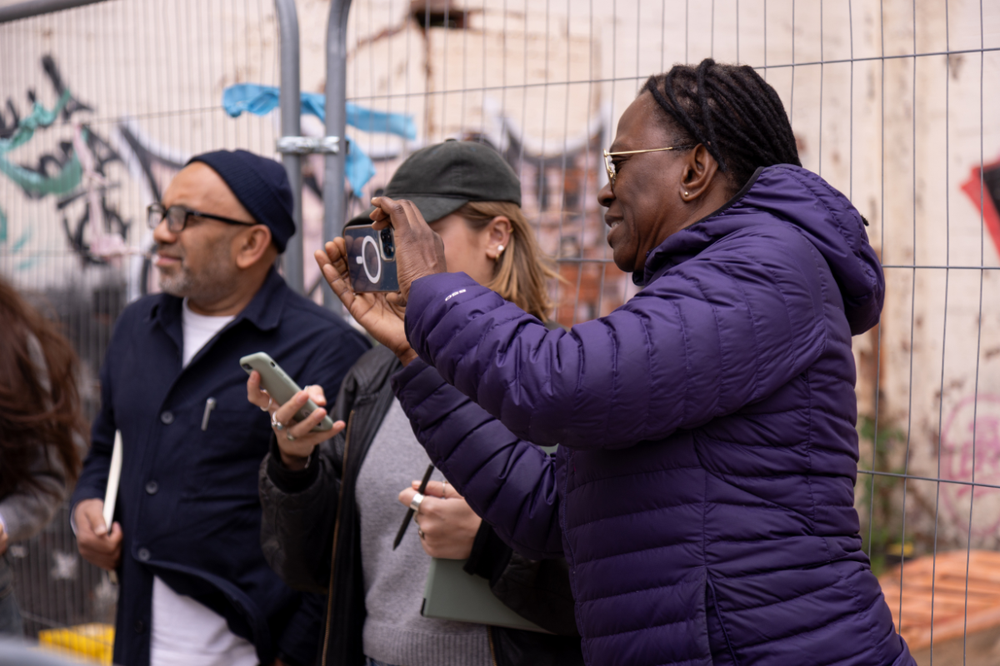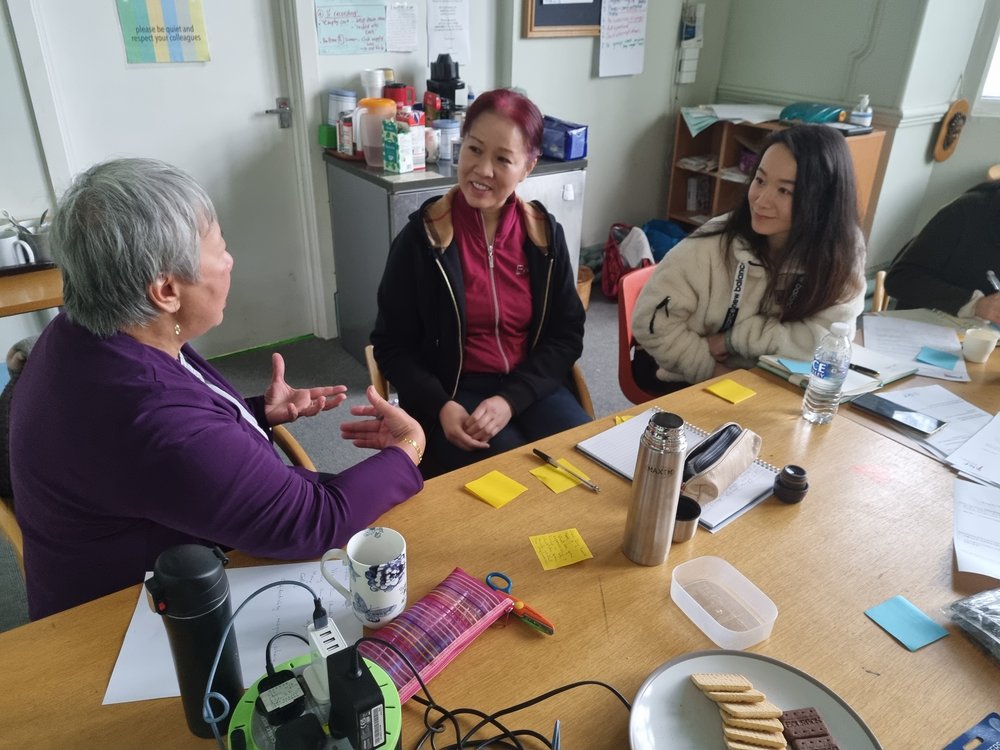Read our guidance on applying for support in Creative, Confident Communities. For work towards the priorities in this area, we mean communities connected by a place.
You can use the pink 'Back to top' button on the bottom left hand of your screen or scroll up to go back here.
Applying for support in Creative, Confident Communities
We look for work that:
- Puts the place first: by this, we mean reflects the unique character and needs of the local area and its people.
- Is community-led and collaborative: by this, we mean local people are at the heart of the change and have decision-making power. For us, the process is just as important as the outcomes.
- Leaves a positive legacy: by this, we mean developing long-term community capacity and resilience.
- Prioritises equity: by this, we mean the principles of fairness and equity are embedded in the approach, and the work engages and represents the diverse communities in a place.
- Creates long-term, sustainable change: by this, we mean aims to disrupt and change what does not work and to push things forward in a new way.
- Has scope to spread: by this, we mean work that can expand its influence beyond the initial impact and our funding.
Our funding priorities
We have three priorities:
- Communities working together for change
- Community driven enterprise and regeneration
- Community-led art and creativity
In each priority, we have identified a number of long-term outcomes. We want to know how your work contributes to these.
In addition to this guidance, we recommend watching our pre-application Q&A webinar for Creative, Confident Communities.

Civic Square
Glossary
See an explanation of key terms we use in relation to our work in Creative, Confident Communities
Communities working together for change
Communities working together for change
-

-
We have three long-term outcomes in this priority:
- Local people come together to determine equitable and aspirational visions of what they want their community to be.
- Communities and their local corporate, cultural, public, voluntary and community sectors, work better together to achieve collective change.
- Local people are able to exert more influence over the decisions that affect their lives and are the drivers of change.
Please note: applications under this priority will need to demonstrate how the work meets all three long-term outcomes. This is an update to the previous guidance to more accurately reflect the type of work we are supporting.
Explore recent grants in Communities working together for change.
1. Local people come together to determine equitable and aspirational visions of what they want their community to be.
We want to support work that:
- Provides the opportunity for communities to safely connect, convene and organise themselves to identify what their local priorities for change are.
- Provides space for local people to create and share positive and hopeful narratives about what their community is and what they want it to be.
- Is representative of the diversity of the communities in the local area.
2. Communities and their local corporate, cultural, public, voluntary and community sectors, work better together to achieve collective change.
We want to support work that:
- Takes a partnership approach where the corporate, cultural, public, voluntary, and community sectors work together with local people to deliver collective change.
- Strengthens and sustains collective decision making between local people and local public agencies and civil society organisations.
3. Local people are able to exert more influence over the decisions that affect their lives and are the drivers of change.
We want to support work that:
- Aims to foster and build leadership skills, knowledge, and capacity within communities.
- Identifies and dismantles barriers that prevent marginalised local people from participating in community-led decision making.
- Explores alternative models of local governance and sharing power that leads to greater depth and breadth of involvement by local people in decision making.

People's Voice Media
People's Voice Media is a charity that works with communities across the UK to support and enable them to tell and share their stories and influence services and issues in their local areas.

We're Right Here
We're Right Here is a national campaign for community power calling for legislation, which would devolve power to communities – over how money is spent locally, the design, commissioning and delivery of public services, and ownership of local assets.

Community Organisers
Community Organisers is a national charity that supports grassroots community organising across England. They developed, grown and supported the field of community organising practice by working with local, regional and national organisations from the public, private and voluntary sectors.
Community driven enterprise and regeneration
Community driven enterprise and regeneration
-

-
We have three long-term outcomes in this priority:
- An increase in community owned assets and community wealth-building models drives greater reinvestment in local economies, reducing economic inequality.
- Community-led enterprises are a proven and widely adopted model that underpin fairer local economies.
- Community-led approaches to the local economy positively contribute to nature and climate
Explore recent grants in Community driven enterprise and regeneration.
1. An increase in community owned assets and community wealth-building models drives greater reinvestment in local economies, reducing economic inequality
We want to support work that:
- Demonstrates models of asset ownership or re-investment in local economies that respond to local context and are community-led. We are particularly interested in work that is safeguarding social infrastructure for communities.
- Builds the capacity of communities to manage or own assets themselves through training, advice, access to finance and/or by creating local support infrastructure organisations and networks. We are particularly interested in work that is supporting communities that have been historically marginalised.
- Builds new partnerships and ways of working between the public, private and community stakeholders in a place to enable community asset ownership.

Community Land Scotland
Community Land Scotland’s vision is for the community ownership of land and buildings to be a significant driver of sustainable development across the whole of Scotland.
2. Community-led enterprises are a proven and widely adopted model that underpins fairer local economies
We want to support work that:
- Builds resilience in the community-led enterprise sector and helps it to scale – either at a national or local level. This could be through capacity building, advice, network building, funding etc.
- Is testing and building understanding of how community-led enterprises can access alternative models of finance.
- Addresses the systemic barriers that can prevent minority-led community enterprises from accessing advice and finance.
- Supports the community-led enterprise sector to become more established and helps to demonstrate its economic, social and environmental value to a wider audience
It is unlikely that we would fund a sole community-led enterprise under this long-term outcome unless they can demonstrate how they are delivering against the criteria above and can offer learning for the wider sector.

Participate Projects
Participate Projects supports people and organisations across West Yorkshire to develop and grow their ideas into sustainable projects and enterprises.
3. Community-led approaches to the local economy positively contribute to nature and climate.
We want to support work that:
- Demonstrates alternative models or approaches to economic development which drive positive impacts for nature and climate (e.g. circular economy or Donut Economics principles).
- Builds community knowledge, trust and consensus around climate change and puts local people at the heart of decision-making and action.
Community-led art and creativity
Community-led art and creativity
-

-
We have three long-term outcomes in this priority:
- Local people and local artists lead creative and cultural activity in their communities.
- A collaborative approach to creativity and culture enables people to work together to strengthen their community.
- Local and regional cultural strategies are shaped by citizens and impact wider decision making and agendas for change.
We will consider proposals that include activity in schools only where this approach is part of a wider engagement plan (e.g. a programme with multiple routes for community co-creation, one of which takes place in schools). We would not support work that is only taking place in schools or work that is part of the curriculum.
Please note: all applications in this priority will need to contribute to both the first and second long-term outcomes. If your work is a good fit to the third long-term outcome, your application will need to contribute to all three long-term outcomes.
1. Local people and local artists lead creative and cultural activity in their communities.
We want to support work that:
- Demonstrates the impact of community-led creativity and culture making change in neighbourhoods.
- Is representative of the diversity of the communities in the local area.
- Is managed using co-leadership models between local people and organisations.

Back to Ours
Back to Ours is a community-led creative arts organisation, producing outstanding arts and cultural experiences with and for the people of Hull.

Restoke
Restoke is an arts organisation based in Stoke on Trent which addresses social issues through creative co-production, participation, and interdisciplinary practice.
2. A collaborative approach to creativity and culture enables people to work together to strengthen their community.
We want to support work that:
- Involves collaboration between local people and organisations from the arts and other sectors.
- Strengthens and sustains collaborations between local people and organisations to create change.
- Is part of local, regional or national alliances or networks that share learning and demonstrate the benefits of community-led creativity.

Create Gloucestershire
Create Gloucestershire is a network of people and organisations from across the arts and cultural sector. They connects artists, arts organisations, funders and audiences/participants together in new ways, encouraging dialogue and incubating the ideas that emerge.
3. Local and regional cultural strategies are shaped by citizens and impact wider decision making and agendas for change.
We want to support work that:
- Uses creativity to create routes for people to set local agendas and take part in decision-making in their neighbourhoods.
- Aims to build support from policy-makers and funders for involving local people in designing strategies for culture and creativity and other local decision-making.

Citizens in Power
Citizens in Power works with communities, local authorities, and third-sector organisations to co-design ways for communities to lead decision-making and shape the future. It uses the citizen assembly model to support local people to lead in decision-making.

Submit and application
If you think your work is a good fit to our strategy, you can submit an Expression of Interest (EOI). Click the button below to learn more about each stage of the application process and a link to submit an EOI.

People's Voice Media
How we make decisions
We get far more applications than we can fund. To help us make a decision about what applications to take forward, we look at a range of factors based on how strong a fit the work is to our strategy and how well-placed the organisation is to do the work.